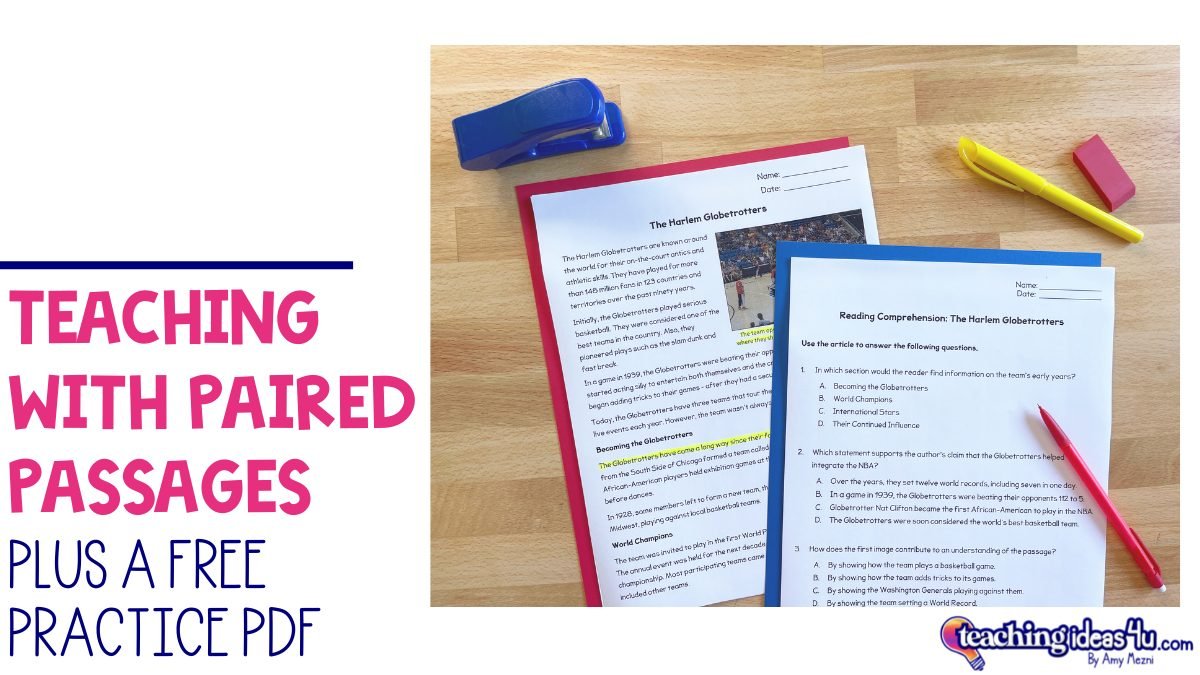Teaching With Paired Passages
Students with weak reading skills will need to be taught specific strategies to help them break down and remember the content of both texts. Remember, students cannot write an effective essay if they can’t read the texts. Which skills you need to teach will depend on what your students need. Some of your students may need to learn how to make notes on the main ideas in each paragraph, while other students may still need phonics lessons to break down words. (Yes, even in middle and high school - if your students cannot cold-read texts correctly, they probably need phonics.)Take the time to conference with each student, have them read aloud to you to hear how well they can sound out words, and ask probing questions to determine their recall and comprehension level. If you support each student at their skill level, you will get greater results when they have to read multiple texts in one sitting.
Start Small
You wouldn’t build a house if you had never built anything before - you would start with something small, like a tray. The same goes with essay writing. Students need to build their skills one step at a time. After you have gotten to know your students, you will know what skills they already have and can start from there. For example, if your students are not strong paragraph writers, begin with writing an effective paragraph. At first, just practice writing a topic sentence. Once that is mastered, move on to selecting supporting details. Next, add closing sentences. I had a teacher friend who used this method with her students with great success - and it prevented the students from writing a lot of terrible essays and her from grading a million ineffective papers. She was able to give students feedback immediately, which helped them build their writing skills faster. Another example would be reading one essay instead of several. Yes, we need students to be able to synthesize information, but trying to build that skill if they struggle to comprehend one essay will be a struggle in futility. My son has a vision processing issue. Even as a high schooler, he struggled to sound out words and recall what he read. His school insisted on having him take practice test after practice test without ever helping him with his underlying weaknesses. And guess what? He continually got the same score, which frustrated the both of us. (We ended up hiring a private tutor who specialized in students with dyslexia, and we finally saw his skills improve.)Bottom line: ask your students to improve their abilities one step at a time. To help you plan your lessons, here are some of the skills students need to have to successfully write an essay from paired passages:
Read, recall, and comprehend one text.
Read, recall, and comprehend multiple texts on the same or related topics.
Identify main ideas and key details.
Take effective notes to remember what they read.
Synthesize information from multiple texts. (There are many reading skills that are needed to do this, including the ability to compare and contrast information.)
Understand and answer an overarching question. (Correctly interpret what the question is asking.)
Select a topic, and write a clear topic sentence.
Select and describe supporting evidence.
Identify the evidence in the texts and be able to annotate where the evidence is located.
Organize their thoughts logically into multiple paragraphs. (Create an outline to do this.)
Explain why the supporting facts are important. (Analysis.)
Write a concluding paragraph.
Model, Model, Model
Everyone learns differently. Some of us learn by listening or doing, but others need to see something to understand it. Teachers who model how to write a topic sentence and identify the main ideas in the texts will help students understand what to do. You will most likely need to model skills more than once, so be sure to plan enough time for practice. (Time is always short, I know. This is why integrating subjects and skills is important.)Showing student samples can be very effective. Just be careful not to embarrass anyone by showing their work as a bad example - that can be defeating. I always tried to use examples from other classes, and I never showed names. I also always started with a positive about each sample. You could also create samples instead of using student work. Also, remember to model your thinking at each stage. How did you decide which facts were important? Why did you select the topic? Students need to hear how you made those decisions.
Practice Early and Often
When students need to answer questions from paired passages, they need to use higher-level thinking skills to synthesize the information. Students need a lot of practice to develop these skills, so it is important for you to practice often - do not wait until right before state testing. I recommend starting early in the year - after you get a good idea of your students’ abilities. Again, integrating reading and writing skills into your content areas will make it easier to find the time. Breaking essay writing into much smaller parts will also help - I know grading essays often slows the entire process down. Focusing on just a sentence or paragraph at a time will help you squeeze in writing.
Free Paired Passages
To help you get started reading paired passages and writing evidence-based essays, I created these Sports Paired Passages. The high-interest topics will help hook your students, and you can even integrate them into different areas (reading graphs in math, a geography unit, etc.)
Best of all, they are FREE.


